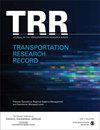Novel Traffic Conflict-Based Framework for Real-Time Traffic Safety Evaluation Under Heterogeneous and Weak Lane-Discipline Traffic
IF 1.8
4区 工程技术
Q3 ENGINEERING, CIVIL
引用次数: 0
Abstract
The present study proposed a real-time traffic safety evaluation framework using macroscopic flow variables. To this end, open-access extended vehicle trajectories were employed. Rear-end traffic conflicts and macroscopic traffic flow variables were derived from the trajectory data and were integrated for real-time safety evaluation. The Proportion of Stopping distance ( PSD) accounts for all types of interactions (both safe and unsafe) in the traffic stream; therefore, the same was adopted to analyze the rear-end traffic conflicts. A macroscopic indicator termed “time spent in conflict ( TSC)” was derived to evaluate the rear-end traffic conflicts. Machine learning models, namely, Random Forest (RF), Support Vector Machines (SVM), and eXtreme Gradient Boosting (XGB), were employed to predict TSCs using macroscopic traffic flow variables. The results revealed that the TSC computed based on PSD exhibits a reliable and explainable relationship with the macroscopic traffic flow variables. TSC computed based on PSD revealed that intermediately congested traffic flow conditions are critical in traffic safety and can be attributed to complex traffic phenomena such as traffic hysteresis, traffic oscillations, and increased speed variance. Moreover, a stable relation between traffic safety and traffic flow was suggested for varying threshold values. Among different machine learning models, the RF model was observed as the best-fitted model to predict TSC based on macroscopic traffic variables. TSC quantifies the safety status of a given traffic flow condition, where a higher value of TSC for a particular traffic flow condition indicates that vehicles prevail in the conflicting scenario for a longer time and, therefore, reflect higher operational risk. The developed machine learning model can be employed to predict TSC (operational risk) in real time using the macroscopic traffic flow variables and, therefore, facilitate traffic safety monitoring.基于交通冲突的异构弱车道约束交通实时安全评价框架
本研究提出了一个基于宏观流量变量的实时交通安全评价框架。为此,采用了开放通道扩展车辆轨迹。从轨迹数据中导出了追尾交通冲突和宏观交通流变量,并将其整合起来进行实时安全评价。停车距离比例(PSD)考虑了交通流中所有类型的相互作用(包括安全和不安全);因此,采用相同的方法来分析后端交通冲突。提出了一种评价追尾交通冲突的宏观指标——冲突时间(TSC)。采用随机森林(Random Forest, RF)、支持向量机(Support Vector Machines, SVM)和极限梯度增强(eXtreme Gradient Boosting, XGB)等机器学习模型,利用宏观交通流变量预测tsc。结果表明,基于PSD计算的TSC与宏观交通流变量的关系可靠且可解释。基于PSD计算的TSC表明,中等拥挤的交通流状况对交通安全至关重要,可归因于交通滞后、交通振荡和速度方差增加等复杂交通现象。在不同的阈值下,交通安全与交通流之间存在稳定的关系。在不同的机器学习模型中,RF模型被认为是基于宏观交通变量预测TSC的最佳拟合模型。TSC量化了给定交通流状态的安全状态,在特定的交通流状态下,TSC值越高,表明车辆在冲突场景中占主导地位的时间越长,因此反映出较高的运行风险。所建立的机器学习模型可以利用宏观交通流变量实时预测TSC (operational risk),从而便于交通安全监控。
本文章由计算机程序翻译,如有差异,请以英文原文为准。
求助全文
约1分钟内获得全文
求助全文
来源期刊

Transportation Research Record
工程技术-工程:土木
CiteScore
3.20
自引率
11.80%
发文量
918
审稿时长
4.2 months
期刊介绍:
Transportation Research Record: Journal of the Transportation Research Board is one of the most cited and prolific transportation journals in the world, offering unparalleled depth and breadth in the coverage of transportation-related topics. The TRR publishes approximately 70 issues annually of outstanding, peer-reviewed papers presenting research findings in policy, planning, administration, economics and financing, operations, construction, design, maintenance, safety, and more, for all modes of transportation. This site provides electronic access to a full compilation of papers since the 1996 series.
 求助内容:
求助内容: 应助结果提醒方式:
应助结果提醒方式:


